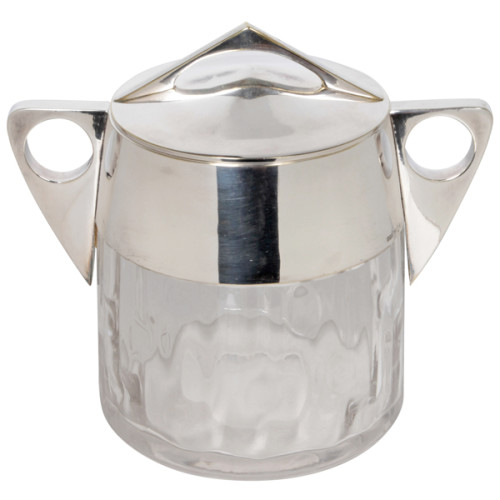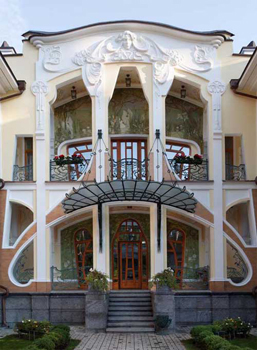Product Description
Gisela Falke von Lilienstein / Berndorfer Metallwarenfabrik Vienna Secession covered box c. 1902



GISELA VON FALKE (b. 1874) Austria
SCHOOL OF KOLO MOSER Austria
BERNDORFER METALLWARENFABRIK Berndorf, Austria
E. BAKALOWITS & SÖHNE Vienna, Austria [retailer]
Covered box c. 1902
Silver plate mounts and cover, blown “meteor” glass.
Marks: BEPWF 1481, maker’s touch marks
For more information on Berndorfer Metallwarenfabrik see: Blühender Jugendstil – Österreich (Art Nouveau in Blossom – Austria), Firmen und Marken (Companies and Marks), Waltraud Neuwirth, II (Vienna: Selbstverlag Neuwirth, 1991), p. 221; Metallkunst, Kunst vom Jugendstil zur Moderne (1889-1939), Karl H. Bröhan (Berlin: Bröhan Museum, 1990) pp. 20-44.
H: 7″ x W: 8″
Price: $9,000
Gisela Falke von Lilienstein / Berndorfer Metallwarenfabrik Vienna Secession covered box c. 1902
DOROTHY RENO GROVER (1908-1975) USA
“California Interior with black cat” c. 1950’s
Oil on Canvas
Canvas: H: 40″ x W: 34 1/2″
Framed: H: 42″ x W: 36 1/2″
Born in Dallas, TX on Sept. 10, 1908 into a pioneer Texas family. (Her grandfather was mayor of Dallas, and Brownsville, Texas is named for him.) Dorothy Reno moved to California with her family at age ten and settled in San Mateo. After graduating from Mills College, she obtained an M.A. degree from UC Berkeley. She wed radio announcer John B. Grover in 1931 and settled in Oakland. In 1971 she bought the former home of artist Glenn Wessels in Berkeley where she remained until her death.
EDWARD WELBY PUGIN (1834 – 1875) UK
“Granville” chair c. 1870
Walnut, klismos-style A-frame back with exposed pegs, shaped seat and base with exposed mortise and tenon joinery.
Illustrated: Victorian and Edwardian Decor: From the Gothic Revival to Art Nouveau, Jeremy Cooper (New York: Abbeville Press, 1987) fig. 117; Nineteenth Century Design: from Pugin to Mackintosh, Charlotte Gere and Michael Whiteway (New York: Harry N. Abrams, Inc., 1993) p.143, pl. 173 (in oak); Catalogue Sommaire Illustré des Art Décoratifs, Musée d’Orsay (Paris: Éditions de la Réunion des Musées Nationaux, 1988), p. 184; Truth, Beauty and Design. Victorian, Edwardian and later decorative art, exhibit. cat. (Fisher Fine Art Limited, London, 1986.) p. 32, No. 50
A “Granville” chair is in both the Permanent Collection of the Metropolitan Museum of Art and the Museum of Modern Art in New York and the Musée D’Orsay, Paris.
H: 33″ x D: 18 1/2″ x W: 18″
Edward Welby Pugin, son of gothic-revivalist A.W.N. Pugin, was thrust into professional and family responsibilities upon his father’s death in 1852 when the young Pugin was only eighteen years of age. His style closely resembled his father’s although his furniture for the Granville Hotel in Ramsgate (1873) had its own robust individuality. Like his father, he designed both church and domestic furnishings, mostly executed by Hardman & Co. of Birmingham, the firm established by his father’s collaborator John Hardman. During his lifetime E.W. Pugin was regarded as the leading Catholic church architect of the High Victorian period, in fact he left for New York in 1873 and set up an office on Fifth Avenue and received commissions for some 30 churches across the U.S., including Chicago and Washington, D.C.
